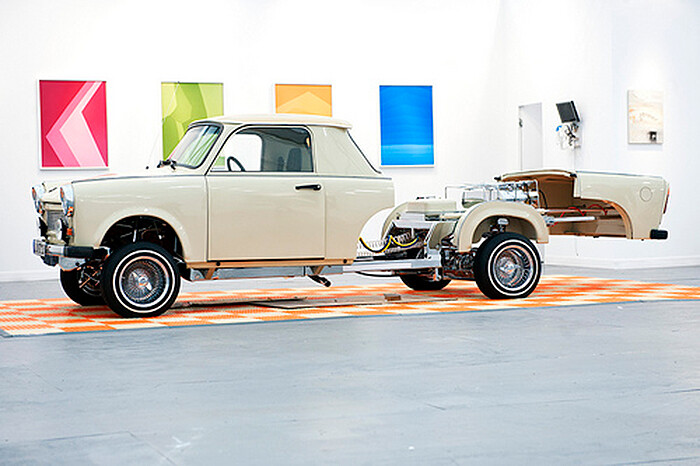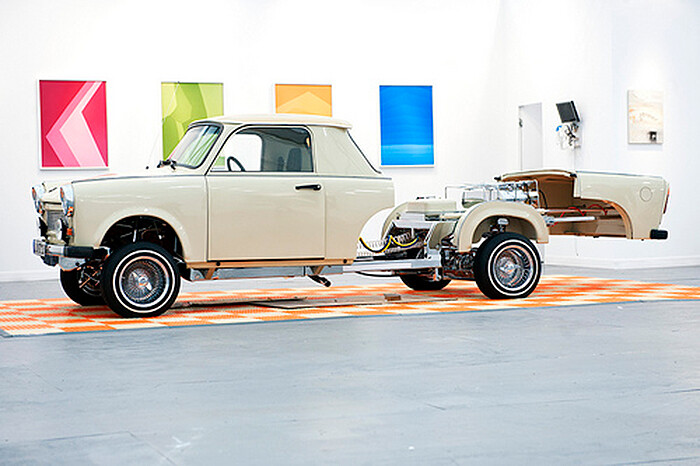As what remains of the public domain is increasingly privatized, art fairs are becoming the real museums of contemporary art. It’s not a coincidence that the London-based Frieze Art Fair’s inaugural appearance in New York City includes a panel titled “Expanding Museums” featuring the directors of the Museum of Modern Art, the Whitney Museum of American Art, and the chairperson of the Metropolitan Museum’s Modern and Contemporary Art Department. It’s also not a coincidence that a version of Edvard Munch’s The Scream sold at a Sotheby’s New York auction for $120 million—the most ever for an artwork at auction—the day before the Frieze Art Fair opened. Furthermore, it’s probably not a coincidence that Frieze is scheduled for roughly the same week as wallets are being opened for Sotheby’s auctions of Impressionist, modern, and contemporary art. And it’s not a coincidence that on the day I visited the art fair I signed an online petition supporting the unionized art handlers that profit-pumping Sotheby’s has locked-out for more than nine months. On a similar note, Frieze New York instigated its own labor troubles when it decided to use non-union workers to erect a massive 250,000 square-foot tent to house the fair on Randall’s Island Park in the middle of the East River.
None of this is irrelevant to a discussion of New York’s first installment of the Frieze Art Fair because it cannot be stated more clearly or less euphemistically: it’s first and foremost about sales. As with any good business, this means keeping the product fresh as well as catering to consumer tastes. New York City’s annual Armory Show—somewhat diminished this spring with a defection of major galleries to Frieze—used to be a place to identify favored artistic styles (e.g., the year after Andreas Gursky’s 2001 MoMA retrospective and amid all the talk about photography that looks like painting, the Armory Show was full of large-scale color photos). Yet trends are tough to spot at Frieze this year, where the work feels consistently homogenous. It’s difficult to pick out showstoppers, such as Mierle Laderman Ukeles’s mirrored sanitation truck at the 2007 Armory Show, though Liz Cohen’s conversion of a mass-produced East German car into an American hot rod (Trabantimino [2002–2010]) at Salon 94 aims to come close. If anything, bright colors are perhaps the most commonly shared trait on display, which might seem odd or superficial to say, but two different friends I ran into at the fair—one an art historian/critic, the other an artist—both confirmed the neon quality to the art, and not only because Tracey Emin’s work (neon and otherwise) appears in the fair’s crucial secondary market.
Overall, the penchant for neon seemed indicative, bordering on garish, perhaps, in the way that luxury’s grin can turn rictus. Appropriation and a shaggy version of Pop art continue to be dominant modes of the day, which helps explain Josephine Meckseper’s popularity and why her work feels completely declawed in this context. But with abounding color everywhere, it’s not a surprise that abstraction is a recurrent strategy: from Rudolf Stingel’s suite of paintings gracing Gagosian’s space, which has been transformed into a near-pristine white cube (even the floor seems shinier than any other booth), to Walead Beshty’s vibrant photographic abstractions at Regen Projects. Sarah Sze makes a strong appearance with two wall-climbing pieces that as their titles indicate—Random Walk Drawing (Air) (2011) and Random Walk Drawing (Grey Landscape) (2012) at Tanya Bonakdar and Victoria Miro, respectively—expand her sculptural investigations into drawing and painting. As with much of Sze’s work, they’re self-contained universes that don’t need an accompanying one—institutional, discursive—to breathe life into them.
At the same time, it isn’t simply their black-and-white contrast that makes works by Barbara Kruger, Adrian Piper, and Hélio Oiticica shine. Kruger’s large-format Too Big to Fail (2012, at Sprüth Magers) is positioned near the south entrance to the fair—the one used by visitors arriving via car (including a fleet of BMWs for VIPs). Kruger’s repurposed declaration is exactly the kind of “lite” ironizing that art fairs love to cast upon their market impulses, but in terms of direct political commentary—and links to the Occupy Wall Street movement—Kruger’s work is a rarity. At the north entrance, for those visitors arriving by shuttle bus, ferry, or yacht, Elizabeth Dee’s area includes six early black-and-white videos by Adrian Piper that similarly stand out, and not only because film and video are otherwise in short supply. Some of the best work under the big tent, and among the most interesting booths at the fair, belongs to Oiticica at Galerie Lelong, which is an exception in offering both a mini-retrospective and a thematic featuring art by established and emerging Latin American artists. Oiticica’s two C-prints (originally 1973) containing appropriated images of Marilyn Monroe decorated with lines of cocaine are among the most striking in the show. I’d buy them.
It used to be that art fairs staged talks, projects, and special commissions as “interventions” into the market format (the art world fluttered when Jacques Rancière gave a lecture at the London Frieze Art Fair in 2005). Frieze New York has plenty of these this year, although they’ve been seamlessly integrated into the weekend, including a workshop conducted by Tim Rollins and K.O.S., a commissioned short story by Rick Moody (though Bret Easton Ellis might have been a more appropriate choice), a talk by Robert Storr on Gerhard Richter’s Atlas, artist interviews, audio pieces, more panels, an outdoor sculpture park, a short film by Allan Sekula with footage from Art Basel Miami Beach, a children’s education program, and even an app. Perhaps most telling is a booth featuring the original plaster cast portraits from John Ahearn and Rigoberto Torres’s 1979 exhibition “South Bronx Hall of Fame.” Originally done free of charge for members of a community experiencing severe economic hardship, this time around, visitors to Frieze can sign up to have casts made by Ahearn and Torres for the right price.










